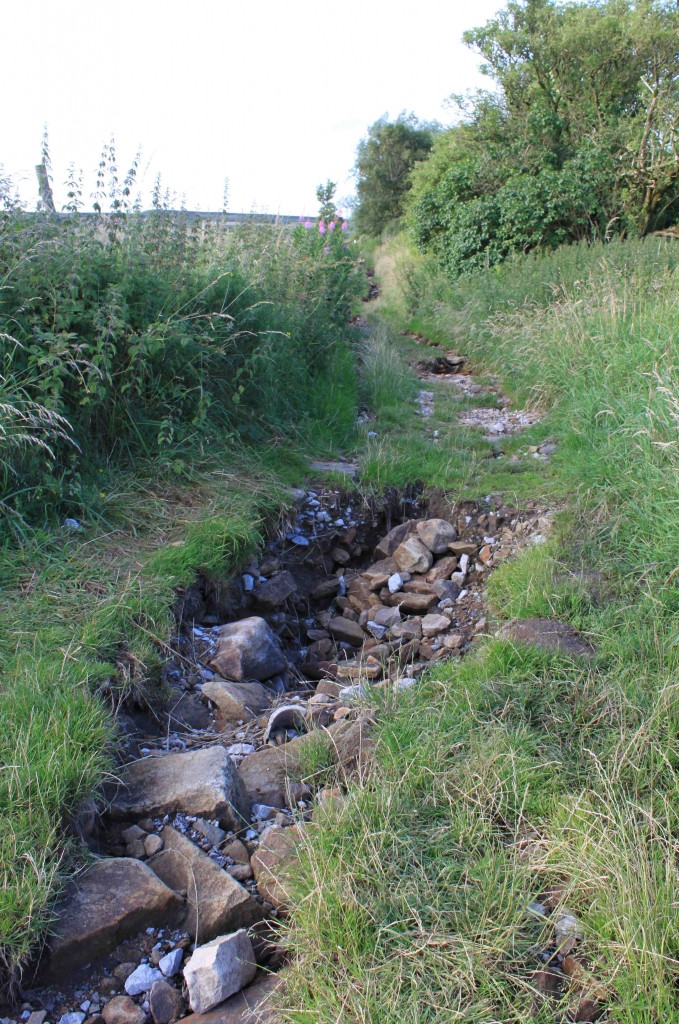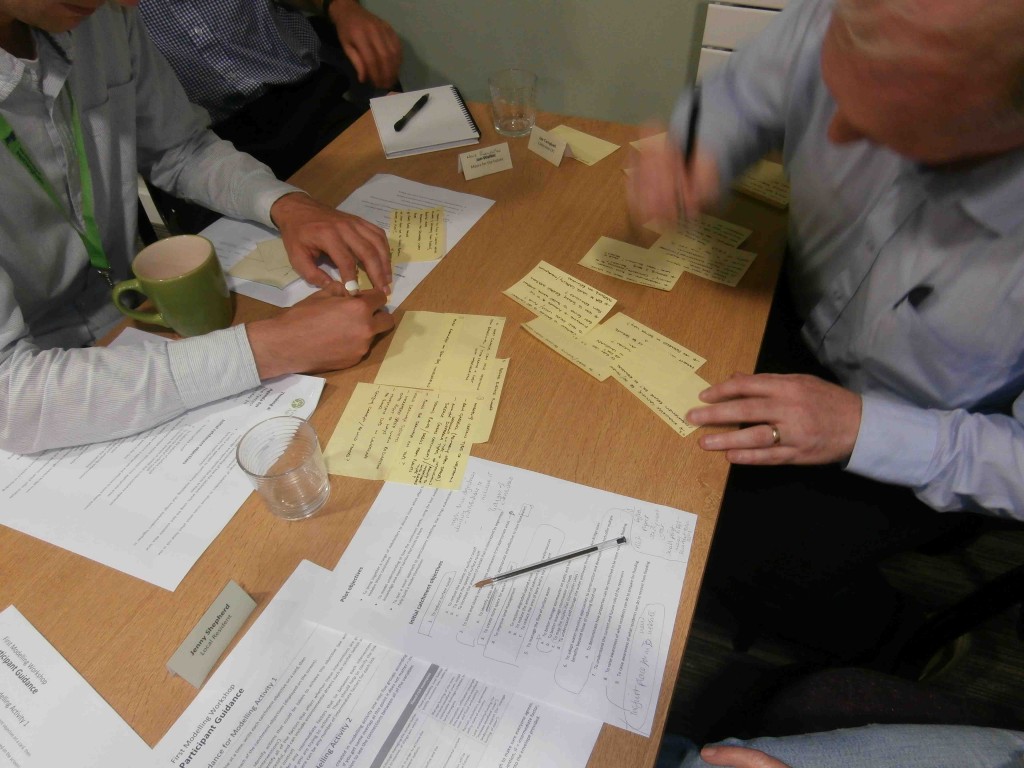Under the guidance of PhD geography student Shaun Maskrey and the Environment Agency’s John Woods, Hebden Bridge residents and organisations last week attended the first of five workshops, where together we’ll create a model for reducing flood risks in the Hebden Water catchment.
I found this workshop interesting in itself – it also struck me that the participatory modelling process looks as though it could be useful for all kinds of local issues. So it’s also worth attending just to learn how this process works.
How Shaun’s participatory modelling process works
Through previous interviews with various Hebden Bridge people, Shaun had made a list of nine initial objectives for reducing flood risks in the Hebden Water catchment:
- reduce surface water runoff
- store and slowly release excess stormwater from appropriate areas
- create more space for water in the river
- improve land management
- manage the flow of surface water
- adopt water-sensitive approaches to construction and development – and demonstrate how properties can be retrofitted to be more resilient to flooding
- understand the current and future role of reservoirs
- raise awareness of what residents can do to prepare for flooding
- raise awareness of what residents can do to recover from flooding
Each of the two groups spent most of the workshop working through this list and coming up with “interventions”, or actions, that might help to achieve these objectives.
Finding out how certain it is that different flood risk reduction measures actually work
Shaun explained in his presentation that you need to know how certain or uncertain any model is about the cause and effect relationships it identifies between different variables. How certain can we be that any of the actions or interventions we think up will help to achieve the relevant flood risk reduction objective?
This is obviously a good question. Having some way of answering it will be vital in deciding what kinds of actions/interventions are likely to have the greatest chance of reducing flood risk.
For example, current knowledge about the effectiveness of changes to land use in reducing flood risks may be quite vague. A 2012 Land Use And Flood Risk Management workshop organised by the Northern Ireland Rivers Agency noted that,
“Presentations and the answers by presenters to questions from the floor suggested that afforestation is unlikely to deliver a significant reduction in run- off during extreme rainfall events. However wet woodland did offer some benefits as it slows the flow and may delay the onset of a flood.”
The Houses of Parliament Parliamentary Office of Science and Technology 2011 Note 396 on Natural Flood Management offers a summary of the policy drivers of this approach to reducing flood risks, its scientific basis, and the implementation of inland natural flood management strategies. It points towards the need for greater certainty about the effectiveness of various Natural Flood Management methods.
To help identify the degree of certainty of different bits of the model, Shaun will be using Bayesian networks. Here is his explanation of how this process works – explained in terms of finding out how certain we can be about the effectiveness of different processes involved in making a decent cup of tea!
Knowledge politics & the Pickering flood reduction project
One of Plain Speaker’s guiding principles is What if everything we think we know is wrong? I’m interested in exploring knowledge controversies as they play out and affect what actually happens in the real world.
How to reduce flood risks is a topic that comes under the heading of “knowledge controversies”. It seems that we simply don’t yet know enough to confidently decide what are the best things to do to reduce flood risk.
In the absence of knowledge – and even in the absence of knowledge about absence of knowledge – sometimes it can seem as if participants in discussions about how to reduce flood risks are trying to police proposals from an uncertain evidence base, and possibly without an awareness that the evidence base is uncertain.
A public research project into flood risk “knowledge controversies” has already been carried out in Pickering, North Yorkshire.
You can read about that study here and here.
Update 3.1.2016: during the disastrous 2015 Boxing Day floods, Pickering’s natural, traditional flood alleviation measures worked – it was one of the few places in Yorkshire at risk of flooding that didn’t flood.
Outcomes of the first workshop
Shaun’s notes on the outcomes of the first workshop are downloadable here.



Will you be following this up with more workshops? I’d like to be involved.
Since the Boxing Day floods, I’ve been in touch with Shaun Maskrey, the PhD student who ran these workshops. He’s up for helping push these ideas forward into actions and to come up to Hebden for a meeting if dates are right for him. I’m hoping Plain Speaker and other groups can help move this whole thing forward and will be posting fresh info when there is any – including anything that you or anyone else want to send.
http://www.theguardian.com/environment/2016/jan/07/working-with-nature-didnt-save-pickering-from-the-floods-it-just-didnt-rain-much
caution and empirical modelling required
http://www.water21.org.uk/wp-content/uploads/2014/10/Stroud-Flood-Study_Adam-Broadhead_Water21.pdf
or enhance traditional farming methods with rain charged irrigation (amongst many other possibilities). 20 min film of flood protecting farming (storing water in reservoirs and soil carbon).
http://www.water21.org.uk/2012/dawn-to-dusk-2015/
This is exciting and excellent.
Another very similar project is carried out in Devon, Scotland with details on the WWF link: In this project residents, businesses, local eco-groups and councils have worked together.. please read this.. the more groups communicate their explorations, the better?
http://www.wwf.org.uk/filelibrary/pdf/slowingflow_web.pdf
I am working and living up on Swan Bank Farm, Cragg Vale.. there are streams and fields, woodlands which drain into the tributaries of Calder, so we are very interested in doing what we can to manage the run-off from the land.
So far in the past 5 years, woodland has been planted and willow plantations established .. in the last few weeks we are willing to do our best on the land we manage to slow down the hygrographs from this site..
We are also looking even deeper into the use of land to follow permaculture practices.. not only plant trees, but establish the growth of food – fruit trees, nut trees.. hedges… and to plant along the streams and wetlands to increase water retention and most importantly soil retention.
Yorkshire Water are also changing their policy to focus more on with slowing down run-off.. it is surely good to work with them too? They have teams of hydrologists and policy makers?
recent presentation here for British Hydropower Association that explores association between hydro & flood control : http://www.water21.org.uk/2033/agenda21-and-hydropower-in-gloucestershire/
No but any profits from energy generated could go to flood defences / flood awareness.
Your project looks really great – here is a presentation that touches on how small hydro can help flood control :
https://docs.google.com/file/d/0B22I7EPwHUYTUUlJdEhwUEdhLTA/edit?usp=sharing
Julian (www.water21.org.uk)
Useful reference in New York Times (21 July) that explains some of the identical problems we are experiencing here in UK in resolving causes & effects of climate change (flood & drought).
(paragraph 8* –>)
“*Fortunately, there are dozens of time-tested strategies that our best farmers and ranchers have begun to use. The problem is that several agribusiness advocacy organizations have done their best to block any federal effort to promote them, including leaving them out of the current farm bill, or of climate change legislation at all. ”
“One strategy would be to promote the use of locally produced compost to increase the moisture-holding capacity of fields …”
“ … we need to reduce the bureaucratic hurdles to using small- and medium-scale rainwater harvesting and grey water … urban and rural food production can be greatly enhanced through proven techniques of harvesting rain and biologically filtering grey water … ”
There is much here of relevance – particularly impinging on quick & cheap resolution of causes and effects of climate change; with similar processes seemingly corrupting UK energy policy and markets.
http://www.nytimes.com/2013/07/22/opinion/our-coming-food-crisis.html?pagewanted=1&ref=general&src=me&_r=3&
Sounds interesting. I think I might have added ‘generate energy from micro hydro schemes’ to the list of priorities.
Interesting idea – not sure how micro hydro schemes would reduce flood risks though?
What I meant was that micro hydro could potentially be built in to water management / flood protection schemes.